Readings Newsletter
Become a Readings Member to make your shopping experience even easier.
Sign in or sign up for free!
You’re not far away from qualifying for FREE standard shipping within Australia
You’ve qualified for FREE standard shipping within Australia
The cart is loading…






Of the many techniques that have been applied to the study of crystal defects, none has contributed more to our understanding of their nature and influence on the physical and chemical properties of crystalline materials than transmission electron microscopy (TEM). TEM is now used extensively by an increasing number of earth scientists for direct observation of defect microstructures in minerals and rocks. Transmission Electron Microscopy of Rocks and Minerals is an introduction to the principles of the technique and is the only book to date on the subject written specifically for geologists and mineralogists. The first part of the book deals with the essential physics of the transmission electron microscope and presents the basic theoretical background required for the interpretation of images and electron diffraction patterns. These explanations require mathematics, but nothing more advanced than elementary differential and integral calculus is used. A knowledge of elementary crystallography is assumed, and some familiarity with optics and electromagnetic theory is helpful but not essential. The final chapters are concerned with specific applications of TEM in mineralogy and deal with such topics as planar defects, intergrowths, radiation-induced defects, dislocations and deformation-induced microstructures. The examples cover a wide range of rock-forming minerals from crustal rocks to those in the lower mantle, and also take into account the role of defects in important mineralogical and geological processes.
$9.00 standard shipping within Australia
FREE standard shipping within Australia for orders over $100.00
Express & International shipping calculated at checkout
Of the many techniques that have been applied to the study of crystal defects, none has contributed more to our understanding of their nature and influence on the physical and chemical properties of crystalline materials than transmission electron microscopy (TEM). TEM is now used extensively by an increasing number of earth scientists for direct observation of defect microstructures in minerals and rocks. Transmission Electron Microscopy of Rocks and Minerals is an introduction to the principles of the technique and is the only book to date on the subject written specifically for geologists and mineralogists. The first part of the book deals with the essential physics of the transmission electron microscope and presents the basic theoretical background required for the interpretation of images and electron diffraction patterns. These explanations require mathematics, but nothing more advanced than elementary differential and integral calculus is used. A knowledge of elementary crystallography is assumed, and some familiarity with optics and electromagnetic theory is helpful but not essential. The final chapters are concerned with specific applications of TEM in mineralogy and deal with such topics as planar defects, intergrowths, radiation-induced defects, dislocations and deformation-induced microstructures. The examples cover a wide range of rock-forming minerals from crustal rocks to those in the lower mantle, and also take into account the role of defects in important mineralogical and geological processes.